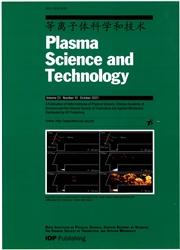杂质对离子温度梯度驱动湍流输运影响的陀螺-朗道流体模拟
IF 1.8
3区 物理与天体物理
Q3 PHYSICS, FLUIDS & PLASMAS
引用次数: 0
摘要
摘要基于四场陀螺-朗道流体(GLF)模型,采用扩展流体代码(ExFC)对含碳杂质和热电子的托卡马克核心等离子体微湍流进行了全局模拟,研究了杂质对离子温度梯度(ITG)驱动的托卡马克核心等离子体湍流输运的影响。给出了保证大块离子和杂质自洽演化的归一化GLF方程的多种形式。利用旋流器基本情况(CBC)的参数化剖面,采用良好基准的ExFC进行了不同杂质密度剖面的模拟。在固定温度分布下,块状离子在准稳态时的湍流热扩散系数通常低于不含杂质时的湍流热扩散系数,这与线性和准线性预测相反。温度梯度和热扩散率的变化呈现出一个快速的弛豫过程,表明杂质外峰谱的失稳是一种瞬态响应。此外,不同剖面的杂质效应会明显影响非线性临界温度梯度,而非线性临界温度梯度可能以线性效应为主。这些结果可能证明杂质可能通过调节热扩散系数和临界温度梯度来改善等离子体约束。本文章由计算机程序翻译,如有差异,请以英文原文为准。
Gyro-Landau-fluid simulations of impurity effects on ion temperature gradient driven turbulence transport
Abstract The impurity effects on ion temperature gradient (ITG) driven turbulence transport in tokamak core plasmas are investigated numerically via global simulations of microturbulence with carbon impurities and adiabatic electrons using extended fluid code (ExFC) based on a four-field gyro-Landau-fluid (GLF) model. The multispecies form of the normalized GLF equations guaranteeing self-consistent evolution of both bulk ions and impurities is presented. With parametric profiles of the cyclone base case (CBC), well-benchmarked ExFC is employed to perform simulations focusing on different impurity density profiles. For fixed temperature profile, it is found that the turbulent heat diffusivity of bulk ions in quasi-steady state is usually lower than that without impurity, which is contrary to the linear and quasi-linear predictions. The evolutions of the temperature gradient and heat diffusivity exhibit a fast relaxation process, indicating that the destabilization of the outwardly peaked impurity profile is a transient state response. Furthermore, the impurity effects of different profiles can obviously influence the nonlinear critical temperature gradient, which are likely to be dominated by linear effects. These results may evidence the plasma confinement improvement by the impurities probably through adjusting both heat diffusivity and critical temperature gradient.
求助全文
通过发布文献求助,成功后即可免费获取论文全文。
去求助
来源期刊

Plasma Science & Technology
物理-物理:流体与等离子体
CiteScore
3.10
自引率
11.80%
发文量
3773
审稿时长
3.8 months
期刊介绍:
PST assists in advancing plasma science and technology by reporting important, novel, helpful and thought-provoking progress in this strongly multidisciplinary and interdisciplinary field, in a timely manner.
A Publication of the Institute of Plasma Physics, Chinese Academy of Sciences and the Chinese Society of Theoretical and Applied Mechanics.
 求助内容:
求助内容: 应助结果提醒方式:
应助结果提醒方式:


